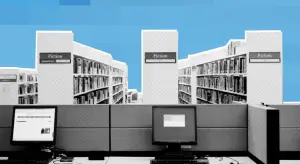NYC bookworms now can access library books from their smartphones
A new app from the New York Public Library will give its patrons instant access to the 300,000 e-books and other materials in its digital collection.
Called SimplyE, the app allows New York library card holders to login and download materials straight to their smartphone or device, and offers a text-to-speech capability for those who are visually impaired.
The launch marks one of the latest efforts by libraries to offer apps and websites that help their patrons “check out” electronic media, like e-books, music and videos. According to an annual survey from the Library Journal, “e-books are firmly ensconced in public libraries,” with 94 percent of libraries offering the materials to their patrons. And OverDrive — the leading e-book vendor to libraries, according to the survey — has recently reported its own gains.
Indeed, Nora Lyons, a publicist for New York Public Library, said the institution released the app last month after seeing a 241 percent rise in the use of its electronic material use over the last five years. Prior to the new app, people downloaded electronic materials through the library’s website.
“We’re very happy with the response to the app,” she said in an email.
Further down the East Cost in Washington, D.C., the library system has also been experiencing a surge of interest in electronic materials. George Williams, the District of Columbia’s public library press secretary, said about 25 percent of the materials patrons checked out last fiscal year were digital.
“There’s absolutely a growth in e-books in library use — I also think there’s a growth in e-books, period,” he told StateScoop.
The D.C. library system, which is composed of about two dozen brick-and-mortar libraries, can lend out up to $700,000 worth of digital book licenses a year, he said. It started offering e-books in 2011, using platform from vendor OverDrive to allow patrons to download books to their Kindle e-readers. From there, interest grew.
OverDrive was by far the preferred vendor, according to a journal survey, followed by “no preference.” Baker & Taylor Axis 360 and 3M Cloud Library came in distant third and fourth respectively. These vendors offer platforms through which patrons can access content through apps or the library’s website.
But some organizations are working on building a more universal system. Institute of Library and Museum Services, a federal independent agency, is collaborating with the nonprofit advocacy group Digital Public Library of America to develop a national digital platform that public libraries across the country can use to provide digital content.
One promising app is Open eBooks, which is free for kids from low-income households and contains thousands of popular and award-winning titles. The Digital Public Library of America, nonprofit First Book and the New York Public Library developed the app with funding from the agency. The app’s launch earlier this year is part of the White House’s ConnectED Initiative, which focuses on making digitized information available to “encourage a love of reading and serve as a gateway to children reading even more often,” even outside of school, said Digital Public Library of America’s eBook Program Manager Michelle Bickert in an email.
“The initiative is designed to address the challenge of providing digital reading materials to children living in low-income households, and offers unprecedented access to quality digital content, including a catalog of e-books valued at more than $250 million,” Bickert wrote.
Williams said it’s the responsibility of libraries to meet their patrons where they are. When Hurricane Sandy struck the city in 2012, the library saw an explosion of D.C. bookworms downloading materials from their site.
“People were downloading e-books because they were trapped in their houses,” he said. “It allows us to give customers the type of books they are interested in reading in the format that they are used to reading.”
He added, “It’s part of the library’s role to offer books and other content to the public in the same ways they would find it on their own.”






